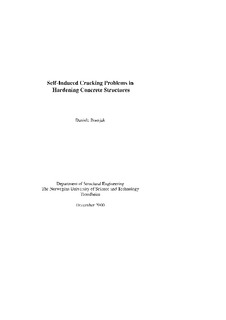| dc.description.abstract | This thesis deals with prediction of early age cracking caused by restrained temperature dilation and autogenous deformation. Traditonally, prediction of early-age cracking has been based on temperature criteria. The temperature criteria alone are, however, not sufficiently accurate for cracking prediction. Stress-strain criteria are more reliable because they consider all the crucial factors: thermal dilation, autogenous deformaion, mechanical properties and restraint condtions.
The purpose of this dr.ing. project is to extend the general appliicability of stress/srain based curing technology, and to contribute to better understanding and better prediction of stresses during hardeing of concrete structures.
In the first part of the thesis the major features of hardening concrete are described and mathematical descriptions of the phenomena are given. Different models are discussed, and on the basis of such discussion, new models have been implemented in the FE program DIANA. First, the equivalent time was introduced in parallel to the degree of hydration, so that all material properties may be considered equivalent-time dependent. it is shown that the simpler and more common equivelent-time based model for the heat of hydration development can describe temperature development with the same accurancy as the degree of hydration based model. Further, the activation energy is made temperature depentent instead of being constant. A modified CEB equation for E.modulus development is implemented. The temperature influence on creep is modified by introducing a thermal transitonal creep term.
A mathematical decription of stress-and strain development in hardening concrete structures is presented, and special attention given to the viscoelastic behavior of concrete. The influence of creep on Self-induced stresses is examined. The emphasis is put on creep importance in different periods of the hardening process. In externally restrained structures, prone to through cracking, creep in the early period (heating phase) reduces the compressive stresses, and consequently increases the tensile stresses in the subsequent cooling period, thus increasing the cracking risk. For internally restrained structures, prone to surface cracking in the early period, creep obviosly reduces the cracking risk. In the cooling phase creep reduces the tensile stresses. For externally restrained structures, the effects of creep in the cooling and heating phases are counteracting, and in some cases they annul each other. The present results do not diminish the importance of creep on thermal stresses, to the contrary, it emphasises the necessity of correct prediction of creep during the whole period of hardening.
Three creep models for young concrete are compared: Double Power Law, Maxwell chain model and Burgers model. The models are calibrated against the same experimental data and used in calculation of therimal stresses. The temperature dependency of the models is also investigated. A good agreement between the Double Power Law and the Maxwell Chain was obtained, wheras the Burgers model, which consists of one Kelvin unit and one viscous damper, gave different results. Although the major reason for the deviation is due to the simplicity of the Burgers model, the deviation is also coused by differnt descriptions of the temperature dependence, and the nature of the test data used in the calibration. Test methods are also discussed, with special weight on the Temperature Stress Testing Machine tests. Although this type of test is indispensible, and very useful to check the validity of the material models and the calculation methods, the shortcomings by using it to predict the creep model parameters are also shown.
Restraint conditions and their influlence on thermal stresses were also investigated. Different ways of modelling the structure and the interaction with the subgrade were analysed and compared. Influence of the stiffness of the ground and the structural geometry on thermal stresses and cracking risk was investigated by means of 3D analyses.
The last part of the work is numerical simulation of temperature and stress/strain development in real structure, the Maridal culvert in Olso. A comprehensive laboratory test program was performed at NTNU to identify material parameters. Both thermal and mechanical properaties were tested. Material models were checked in the TSTM for three different realistic temperature histories. Within the Brite-Euram project IPACS a large field instrumentation programme has been carried out to measure temperature and strain development in the culvert. 3D analysis of the foundations and walls in two of the instrumented sections of this structure were performed with DIANA and calculated results are compared to measurements. Deviation between calculated and measured temperature is within range of ±50C. Deviation between calculated and measured strains is about ±50x10-6. Possible reasons of disagreement between calculations and measurements are discussed. When all uncertainties in materail modelling and measuring methods are sonsidered it is concluded that results of the simulation are satisfying. | nb_NO |
